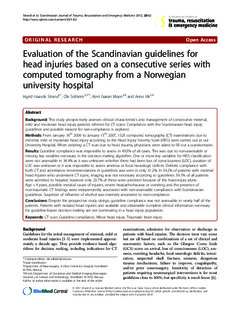| dc.contributor.author | Strand, Ingrid H. | |
| dc.contributor.author | Solheim, Ole | |
| dc.contributor.author | Moen, Kent Gøran | |
| dc.contributor.author | Vik, Anne | |
| dc.date.accessioned | 2015-09-25T12:05:43Z | |
| dc.date.accessioned | 2015-10-01T13:11:53Z | |
| dc.date.available | 2015-09-25T12:05:43Z | |
| dc.date.available | 2015-10-01T13:11:53Z | |
| dc.date.issued | 2012 | |
| dc.identifier.citation | Scandinavian Journal of Trauma, Resuscitation and Emergency Medicine 2012, 20(1) | nb_NO |
| dc.identifier.issn | 1757-7241 | |
| dc.identifier.uri | http://hdl.handle.net/11250/1620383 | |
| dc.description.abstract | Background: This study prospectively assesses clinical characteristics and management of consecutive minimal,
mild and moderate head injury patients referred for CT scans. Compliance with the Scandinavian head injury
guidelines and possible reasons for non-compliance is explored.
Methods: From January 16th 2006 to January 15th 2007, 1325 computed tomography (CT) examinations due to
minimal, mild or moderate head injury according to the Head Injury Severity Scale (HISS) were carried out at our
University Hospital. When ordering a CT scan due to head trauma, physicians were asked to fill out a questionnaire.
Results: Guideline compliance was impossible to assess in 49.5% of all cases. This was due to non-assessable or
missing key variables necessary in the decision making algorithm. One or more key variables for HISS classification
were not assessable in 34.4% as it was unknown whether there had been loss of consciousness (LOC), duration of
LOC was unknown or it was impossible to assess amnesia or focal neurologic deficits. Definite compliance with
both CT and admittance recommendations in guidelines was seen in only 31.2%. In 54.2% of patients with minimal
head injuries who underwent CT scans, imaging was not necessary according to guidelines. 59.1% of all patients
were admitted to hospital, however only 23.7% of these were admitted because of the head-injury alone.
Age < 4 years, possible medical cause of injuries, severe headache/nausea or vomiting and the presence of
non-traumatic CT findings were independently associated with non-assessable compliance with Scandinavian
guidelines. Suspicion of influence of alcohol was inversely associated to non-compliance.
Conclusions: Despite the prospective study design, guideline compliance was not assessable in nearly half of the
patients. Patients with isolated head injuries and available and obtainable complete clinical information necessary
for guideline-based decision making are not dominating in a head injury population. | nb_NO |
| dc.language.iso | eng | nb_NO |
| dc.publisher | BioMed Central | nb_NO |
| dc.title | Evaluation of the Scandinavian guidelines for head injuries based on a consecutive series with computed tomography from a Norwegian university hospital | nb_NO |
| dc.type | Journal article | nb_NO |
| dc.type | Peer reviewed | en_GB |
| dc.date.updated | 2015-09-25T12:05:43Z | |
| dc.source.volume | 20 | nb_NO |
| dc.source.journal | Scandinavian Journal of Trauma, Resuscitation and Emergency Medicine | nb_NO |
| dc.source.issue | 1 | nb_NO |
| dc.identifier.doi | 10.1186/1757-7241-20-62 | |
| dc.identifier.cristin | 964805 | |
| dc.description.localcode | © 2012 Strand et al.; licensee BioMed Central Ltd. This is an Open Access article distributed under the terms of the Creative Commons Attribution License (http://creativecommons.org/licenses/by/2.0), which permits unrestricted use, distribution, and reproduction in any medium, provided the original work is properly cited. | nb_NO |
